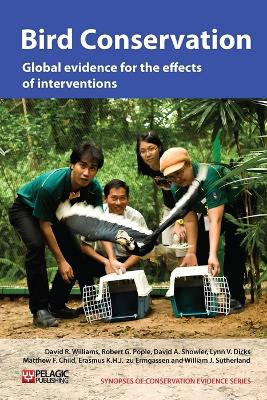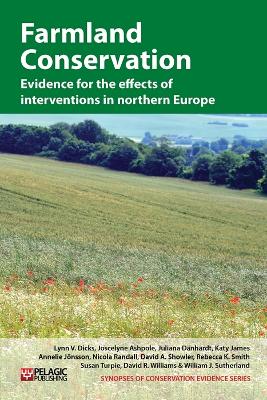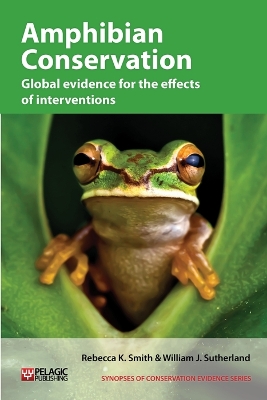Synopses of Conservation Evidence
4 primary works
Vol. 1
Bee Conservation
by Lynn V. Dicks, David A. Showler, and William J. Sutherland
This book brings together scientific evidence and experience relevant to the practical conservation of wild bees. The authors worked with an international group of bee experts and conservationists to develop a global list of interventions that could benefit wild bees. They range from protecting natural habitat to controlling disease in commercial bumblebee colonies.
For each intervention, the book summarises studies captured by the Conservation Evidence project, where that intervention has been tested and its effects on bees quantified. The result is a thorough guide to what is known, or not known, about the effectiveness of bee conservation actions throughout the world. Bee Conservation is the first in a series of synopses that will cover different species groups and habitats, gradually building into a comprehensive summary of evidence on the effects of conservation interventions for all biodiversity throughout the world.
By making evidence accessible in this way, we hope to enable a change in the practice of conservation, so it can become more evidence-based. We also aim to highlight where there are gaps in knowledge.
Evidence from all around the world is included. If there appears to be a bias towards evidence from northern European or North American temperate environments, this reflects a current bias in the published research that is available to us. Conservation interventions are grouped primarily according to the relevant direct threats, as defined in the International Union for the Conservation of Nature (IUCN)’s Unified Classification of Direct Threats.
Vol. 2
Bird Conservation
by David R Williams, Robert G. Pople, David A. Showler, Lynn V. Dicks, Matthew F. Child, Erasmus K.H.J. Zu Ermgassen, and William J. Sutherland
This book brings together scientific evidence and experience relevant to the practical conservation of wild birds. The authors worked with an international group of bird experts and conservationists to develop a global list of interventions that could benefit wild birds.
For each intervention, the book summarises studies captured by the Conservation Evidence project, where that intervention has been tested and its effects on birds quantified. The result is a thorough guide to what is known, or not known, about the effectiveness of bird conservation actions throughout the world.
The preparation of this synopsis was funded by the Natural Environment Research Council and Arcadia.
Vol. 3
Farmland Conservation
by Lynn V. Dicks, Joscelyne E Ashpole, Juliana Danhardt, Katy James, Annelie M. Jonsson, Nicola Randall, David A. Showler, Rebecca Smith, Susan Turpie, and David R Williams
This synopsis covers evidence for the effects of conservation interventions for native farmland wildlife. It is restricted to evidence captured on the website www.conservationevidence.com. It includes papers published in the journal Conservation Evidence, evidence summarized on our database and systematic reviews collated by the Collaboration for Environmental Evidence. It is the thrid volume in the series Synopses of Conservation Evidence.
Evidence was collected from all European countries west of Russia, but not those south of France, Switzerland, Austria, Hungary and Romania.
A list of interventions to conserve wildlife on farmland was developed collaboratively by a team of thirteen experts. A number of interventions that are not currently agri-environment options were added during this process, such as ‘Provide nest boxes for bees (solitary or bumblebees)’ and ‘Implement food labelling schemes relating to biodiversity-friendly farming’. Interventions relating to the creation or management of habitats not considered commercial farmland (such as lowland heath, salt marsh and farm woodland) were removed.
The list of interventions was organized into categories based on the International Union for the Conservation of Nature (IUCN) classifications of direct threats and conservation actions. Interventions that fall under the threat category ‘Agriculture’ are grouped by farming system, with separate sections for interventions that apply to arable or livestock farms, or across all farming types.
Vol. 4
Amphibian Conservation is the fourth in the series of Synopses of Conservation Evidence, linked to the online resource www.ConservationEvidence.com.
This synopsis is part of the Conservation Evidence project and provides a useful resource for conservationists. It forms part of a series designed to promote a more evidence-based approach to biodiversity conservation. Others in the series include bee, bird, farmland and bat conservation and many others are in preparation.
Approximately 32% of the 7,164+ amphibian species are currently threatened with extinction and at least 43% of species are declining. Despite this, until recently amphibians and their conservation had received little attention. Although work is now being carried out to conserve many species, often it is not adequately documented.
This book brings together and summarises the available scientific evidence and experience relevant to the practical conservation of amphibians.
The authors consulted an international group of amphibian experts and conservationists to produce a thorough summary of what is known, or not known, about the effectiveness of amphibian conservation actions across the world.
"The book is packed with literature summaries and citations; a veritable information goldmine for graduate students and researchers. It also admirably provides decision makers with a well-researched resource of proven interventions that can be employed to stem/reverse the decline of amphibian populations." -John G Palis, Bulletin of the Chicago Herpetological Society



